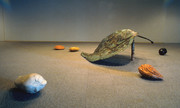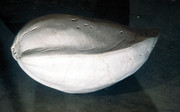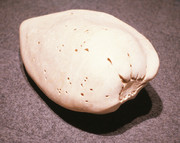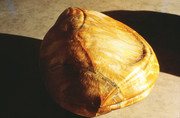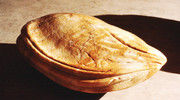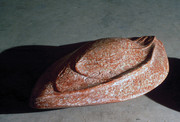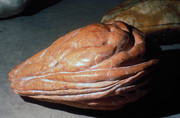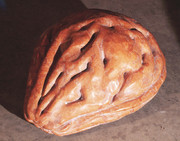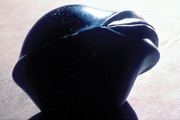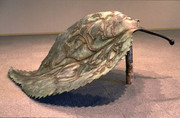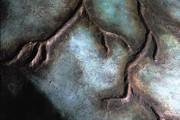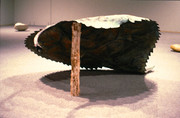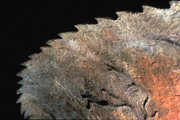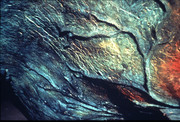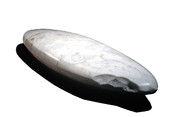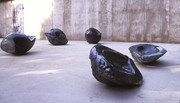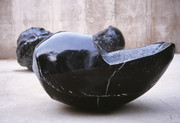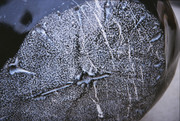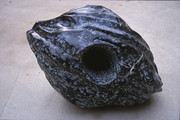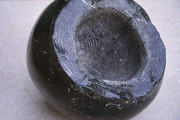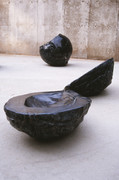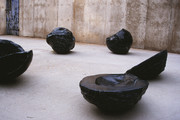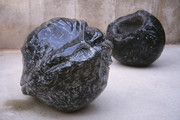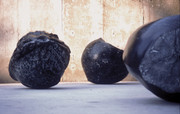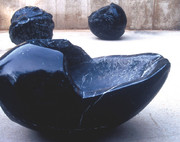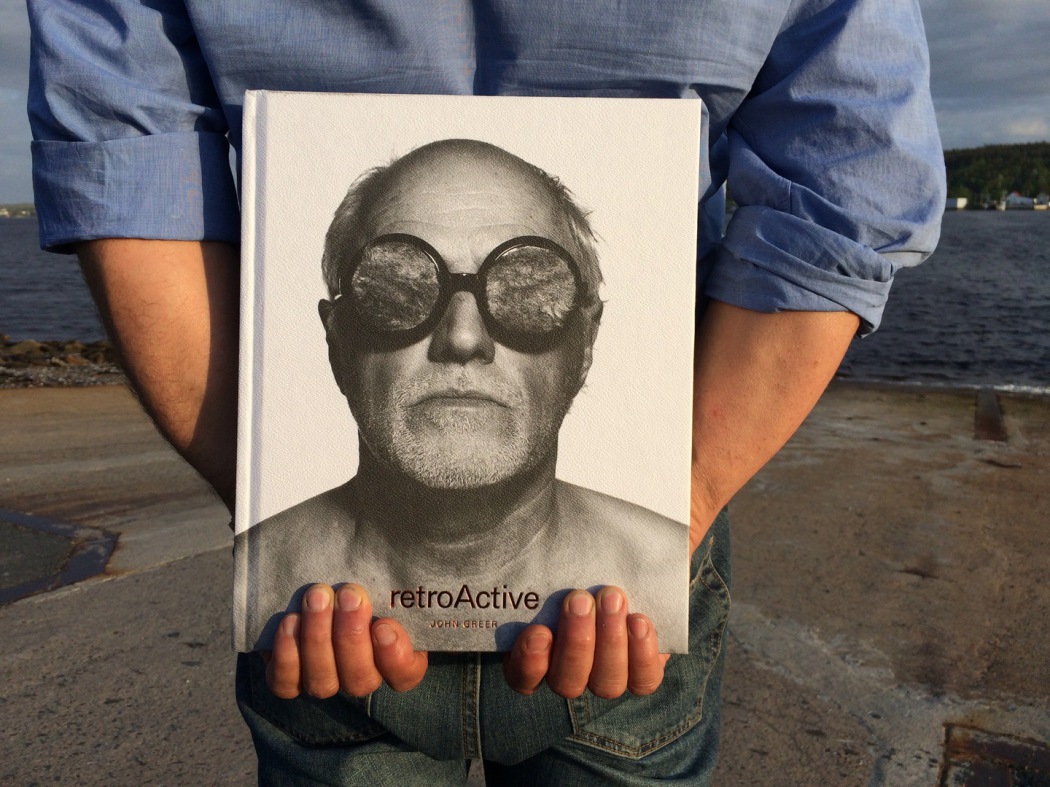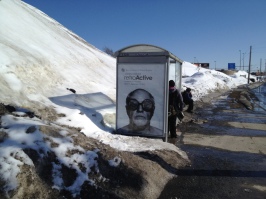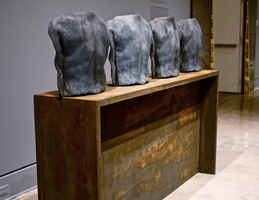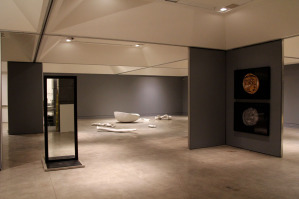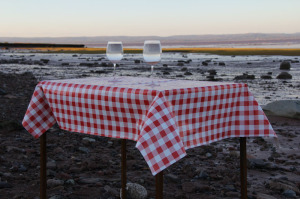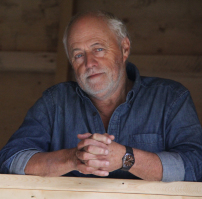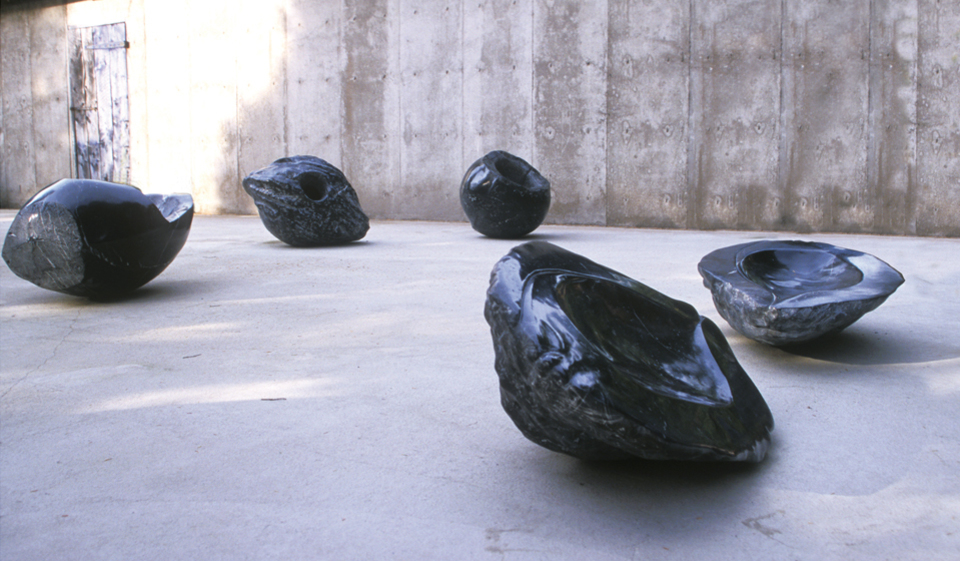
Matter in Balance
Someday they will know how to unlock the stone
and then they will have infinite energy.
Isamu Noguchi
"Reconciliation", 1989 is a sculptural environment that consists of five marble elements in the shape of seeds: an almond, an apricot, cherry, peach and plum kernel, weighing between sixty and three hundred pounds each. These marble sculptures are installed directly on the floor, scattered throughout a room so that there is enough space for a person in order to move around and walk in between the objects. A focal point of the installation is another element, a large bronze object in the shape of a leaf, approximately five by seven feet in size, weighing nine hundred pounds. It is resting upon a wooden pole, which is three feet high, thus creating a sheltered space underneath that almost resembles a cave. The used imagery is underlined by the colour of the materials - the leaf is bluish-green on the upper side and has a dark red-brown colour underneath. The stone pits are made of various types of stones that are rich in colour and create a life aspiration of fruit from fresh to overripe: in pale reddish, a fresh yellow, deep orange, natural white and a veined deep black.
At the first encounter, the created scenery is reviving an "eternal spring" - evoked by the inherent power of the fertility and the life power of the fruit pits. The imagery seems to be familiar so that one is at once reminded of personal experience in a common situation. But this is just the case by looking at the work from a distance - looking at it as if it was an image - as if it was two-dimensional space. But, it is not. These are objects in our world, substantial in their material and not denying their weight. They have a tactile quality as much as they are present in space. In fact, once having entered the room one cannot see the whole installation at once except from a very distant corner - which is essential to the artist. "I want you to be immersed in that field of experience by being aware of what is behind you, measuring into space what is coming up." (John Greer)78. This state of awareness comprises an element of trust. It encourages a belief in our own presence in space among these objects. You have to bend down and investigate in order to see and fully perceive the objects. Greer is referring to a modern conception of space in physics, stating the relativity of space. The distant reception of a work of art is giving place to a tense ambiguity of perception between the reception of an object that seems to be familiar, and an immediate confrontation with objects that share our space on a scale that is in direct relation to human proportion. The ground that we are walking on is a shared place - integrating us in the work of art and placing the art object into real space - removing it from its pedestal.
In "Beyond Modern Art", Jack Burnham writes on "sculpture's vanishing base" regarding its function: "Within the representational idiom in general, the base has served to isolate and emphasize the particular psychology and anecdotal content of the activity it supports." He characterizes the base as an appendage to sculpture which helped to create an "aura and dignity around a favoured object" (Jack Burnham)79. By suggesting that a sculpture stands apart from reality, the base supports a top-heavy approach on art, one that reduces sculpture to an image.
Modern sculpture overcame this aspect by applying various means. The base was integrated in the body of sculpture and thus revived the work. Another way to relinquish the function of the base was to literally ground the sculptures, so that the heroic element of the past was changed into a new naturalness. Later on, artists tried to include movement into sculpture, or even lifted the entire sculpture off from the ground, fixing it in turn at the walls or hanging it from the ceiling.
Greer's floor-bound pieces offer a sensual approach that causes the viewer to reflect on the self and to reposition himself in regard to the work. Siegfried Salzmann mentions in an essay on floor-bound sculpture: "A fundamental element lies in activating the individual perception of the body of the viewer, who is becoming a participant. Floor bound sculpture is using the activity of the body and how it deals with material: consciousness and feeling of an individual physicality. It frequently addresses the orientation by the measurement of the body and evokes it in its individual scale." and " Floor bound sculpture is able to remove artificial intellectual distances, is opposing vertical - mostly traditionally structured - claims. Illusionary effects of a primarily visual appearance lose their importance." (Siegfried Salzmann)80
Salzmann focuses here on an engagement on a mere physical level by referring to minimalist artists who work site-orientated and use measurement, geometric and earth-connected material. The encounter of such a work leads to a repositioning of the own body.
Greer is reaching beyond mere physicality with an applied imagery that was developed over the years in his body of work. Sculpture is physical contact for him, and it works also on various levels through the reference to individual experience.
The big leaf in this installation is a shelter and a cave. It is a place of confidence as long as one acts with caution and "minds" the pole as a balanced, but not stable or fixed rest. The leaf becomes a tomb if its weighing mass is taken out of its resting balance. The tactile qualities underneath (thumb prints and marks from the working process) in connection to the colour (red-brown) create the sense of security of a sheltering cave, a space inside the earth. The scattered marble pits are talking about the force of live, of continuity and the process and potential of growth. The work is reintegrating sculpture into nature, in terms of our natural reality. It is adjusting our relation to "nature", but is talking about a current problematic of urban life, about a placement of self-consciousness as part of a living society.
Greer wrote a long statement on "the enclosing line", which was published in the catalogue accompanying the show "Reconciliation". It is a critique on the dangerous acceptance of the "cropped image", a part of the two-dimensional construct, as reality, the three-dimensional world. Isolation of imagined space, so the artist, is relinquishing the authority of our own physicality. He regards analytical thinking as a powerful tool, but is criticizing our inattentive and thoughtless use of it. Our consciousness in turn is secured by our individual centering. He describes this with an example: "If one says the word "I", the sound resonates from the subjective centre of experience; while on the other hand, if one writes the word "I" and then reads it silently, one has first objectified (projected) oneself form the body, and then brought it into the brain as a seemingly separated idea - no longer the centre of experience, more of an eccentric experience, not having one's axis located centrally."(John Greer)81 So, in fact, the reconciliation that he is putting forward is that of matter (body) and mind. He connects the idea of the center and its balance directly to the phenomenon of illusion (mind) and reality (matter), which are opposing each other in the general acceptance - but should be interacting elements. For him, the main governing force tying the two together is gravity.
It is obvious that Greer's early investigations into illusion are forming the substance of this understanding. He tried to sensitize the viewer towards the general and dangerous acceptance of an illusionary reality built up in one's mind through the encounter with images (especially the mirror image).
A work realized in 1991 is the connecting link that forms the turning point of his interest in these investigations. The "Single Grain of Rice", carved in white Italian marble, is a kind of self-portrait of the artist, or better - another self. A grain of rice, being a manifestation of intelligence and representing for Greer energy potential, is here a singular statement for a subjective position, a subjective consciousness. It is a moment of balance, formed in stone, a substantial material through which gravity is obvious by its weight and density. It seems as if this work is the valve that finally releases the artist's fear of a mentally constructed self - the perception of oneself through or as a mental construct - and serves at the same time as a container to resolve this personal conflict. He comes to an agreement by opposing himself with a self-made form (the size refers to the size of his body), containing spiritually a body of thought, and formally manifesting a body for possible illusions, literally building an outside center for his inner self. Greer even feels that the ideal way of exhibiting the piece would be the single work as center in a gallery room, knowing that people from all around a city would be drawn to this specific space, coming to see a grain of rice.
Several works from 1993-95, the "Black Seeds" are a logical next step in this development. They counterbalance the statement of a full center of energy with an investigation of the substance of the center materialized by a "void".
I am referring to four works which were exhibited in one space, again placed directly on the floor, installed in a distance that creates a physical field of tension for the viewer to engage with. The objects are carved from black marble, and resemble seeds and nuts in their shape. They vary in their individual appearance and do recall form and shape in a size that renders surface details responsive to the human hand. Three of the sculptures form a central void, which is to be perceived through different openings in the stone shells. These holes seem to be "natural" - they do have a broken edge. As discussed earlier, Greer uses this element as a means for a continuum. In fact, the central void is here a proof of the repositioning of elements. The specific kernels are not shown in the work, but are an essential part in their absence.
Greer is shaping the void through the density of heavy mass. The substantiality of the material is underlined by its colour, a black that is suggesting mineral life and helps to "ground" the objects as elements of the world.
By sending the kernels into the world, Greer is talking about a pool of energy that is residing in this world, is actually forming and defining it. Greer is overcoming the esthetical and visual appearance of two-dimensionality by using a substantial sculptors material. His sculpture as pointed out earlier, is - in the world. An image of something can be removed psychologically; a sculpture can only be moved or transformed in its shape.
We can see this work as a continuance of the critique on the "enclosing line". Here, Greer is defining his approach by consciously including the element of the UNKNOWN. It becomes a significant element to this work, and sets it apart from a scientific and systematic attempt. Greer's use of material and natural elements like gravity, mass and density is signified by the respect towards the coherence of elements that is deeper than vision and knowledge are able to capture.
The "unknown" as such was articulated in sculpture before and in order to define Greer's stand, I am introducing two major works, which form antipodes in their approach to that phenomenon: Giacometti's "L'object invisible (Mains tenant le vide)" from 1934/35 and Brancusi's "Sculpture pour aveugles" from 1916.
"The invisible object (hands holding the void)" reveals a true pictorial sensibility. The work formed a peak in the surrealist movement, yet it was a turning point for Giacometti's focus on nature. "I was satisfied with her hands and her head, since they served exactly my purposes. But with the legs, the body and the breast I was absolutely not satisfied. They seemed to be too academic, too traditional. That made me feel like working from nature again." (Alberto Giacometti)82 In fact, the figure works like an image in order to illustrate an idea. The figure is framed and bound. The forming of an empty space, the void formed by the gesture of two hands, is the only part that is reaching into real space. The means, however, are that of constructed thinking. The void-forming hands provide the essential information. This ambiguity of natural space versus illusionary space confronting each other left Giacometti unsatisfied and gave him reason to investigate "nature" as place.
Brancusi's "sculpture for the blinds" has a specific history that is unfortunately denied in the shown picture (a true one does not exist): "It was exhibited enclosed in a bag that had two sleeves through which the viewer's hands could enter."(Henri-Pierre Roché)83 The work is the most reductive one that Brancusi ever did, "it is nothing but an ovoid". By showing the work in the described way, Brancusi denied the notion of abstraction and emphasized the tactile qualities of the work: "He forced the "viewer" to respond to the work in a wholly tactile way."(Eric Shane).84 Shane interpreted that as a Platonic purpose, stating the supremacy of ideas over appearance by forming an idea of what the object looks like. But obviously, making us blind in order to see, gives us a notion of "seeing with the hands". From that point of view, the object is most important in connection to the viewer grasping its form.
Greer's stand is in between those positions. He is using imagery in order to "talk with objects". The unknown is inherent in the work through an appreciation of life as an energy potential in balance. He believes in an inherent essence in matter and manifests that through a respect to form. John Dewey defines this understanding of balance in connection to life and order: "There is in nature, even below the level of life, something more than mere flux and change. Form is arrived at whenever a stable, even though moving, equilibrium is reached. Changes interlock and sustain one another. Wherever there is this coherence there is endurance. Order is not imposed from without but is made out of the relations of harmonious interactions that energies bear to one another. Because it is active (not anything static because foreign to what goes on) order itself develops. It comes to include within its balanced movement a greater variety of changes." (John Dewey)85
The unknown inner space of the discussed works is proof of a center of individuality. In a fourth work, Greer is unfolding the center as a secret to us. Two almost identical halves of a shell leave the traces of an inner kernel, a specific form that filled exactly that space and is gone into the world. The void manifests the reposition of matter, reveals a transitional balance. Greer's concern is characterized by the visual and tactile sculptural extraction of a basic natural force, inherent in all matter - intelligence. He uses this term in connection to all of his work beginning with "Connected Works" in the mid-eighties. Intelligence is manifested in matter as it is surrounding us - and in human expression. With his work, Greer tries to translate this "philosophy", manifesting it in specific fields of experience. He is defining an understanding through a moment of recognition that throws us back in our self, into the silence of our own mind. This silence is combining space and time; it is a moment of equilibrium, which brings us to an understanding, which gives us certainty to rest. This silence is the momentum of reconciliation. In a statement from 1996 John Greer writes: "Ideas dislodge or are dislodged through wonder and consideration. They turn over and reform the human construct, both physically and mentally. They come to rest to make sense in a transitional balance. The realization comes with the SILENCE. Everything always changes, yet something STILL remains."(John Greer)86
78 John Greer in an interview with the author, Berlin, March 1997
79 Jack Burnham, Beyond Modern Sculpture, Georges Brazillers, New York, 1968, pp.19
80 Siegfried Salzmann, Bodenskulptur Kunsthalle Bremen, 1986
81 John Greer, Reconciliation, Regarding the Enclosing Line, Southern Alberta Art Gallery, 1990
82 Alberto Giacometti, Reinhard Hohl Alberto Giacometti, Hatje Verlag, Stuttgart 1971, p.246;
quoted by Dieter Rahn, Die Plastik und die Dinge, Rombach Verlag, Freiburg, 1993, p.255
83 Henri-Pierre Roché, quoted by Eric Shanes in Constantin Brancusi, 1989, Abbeville Press,
New York, pp.74
84 Eric Shane, ibid.
85 John Dewey, Art as Experience, Perigee Books New York, 1993 Neuauflage, p.14
86 John Greer in a statement on the work "Black Seeds"
